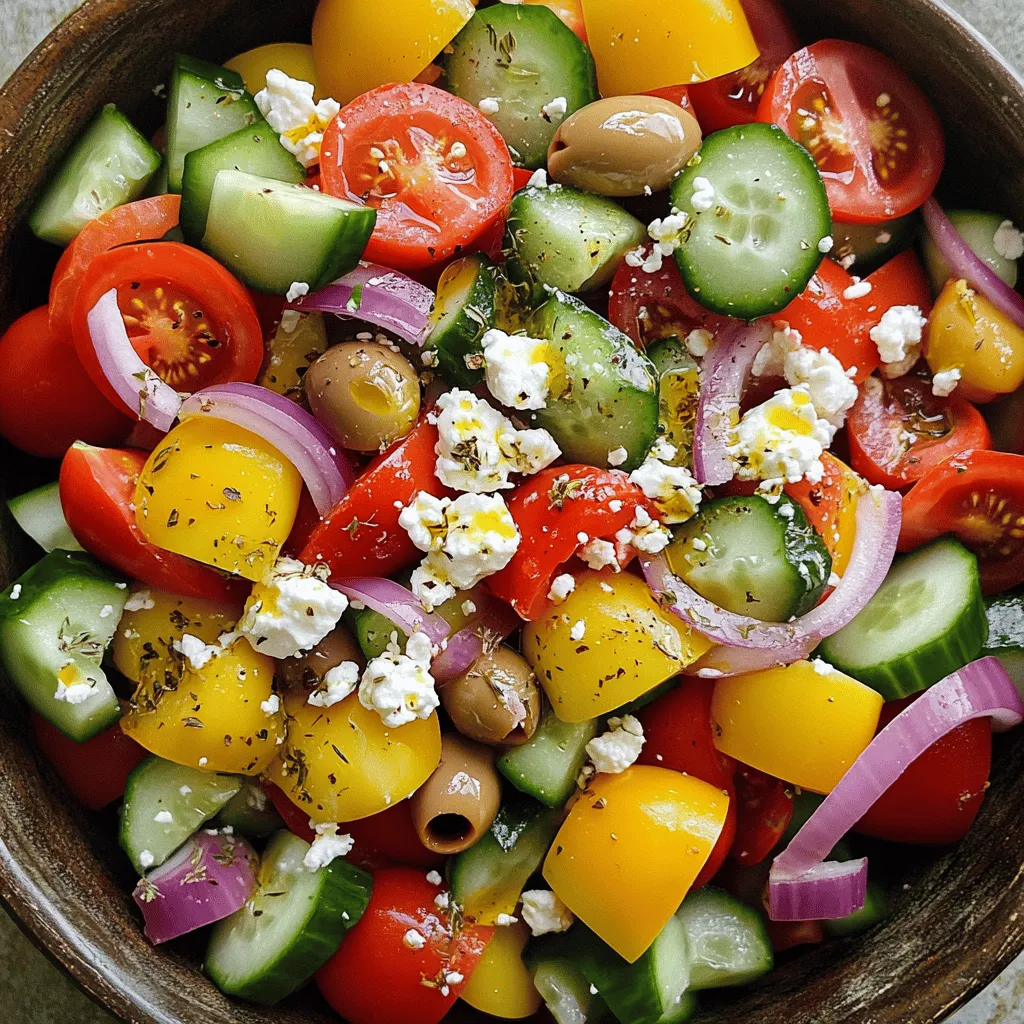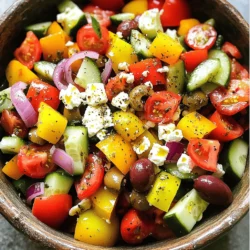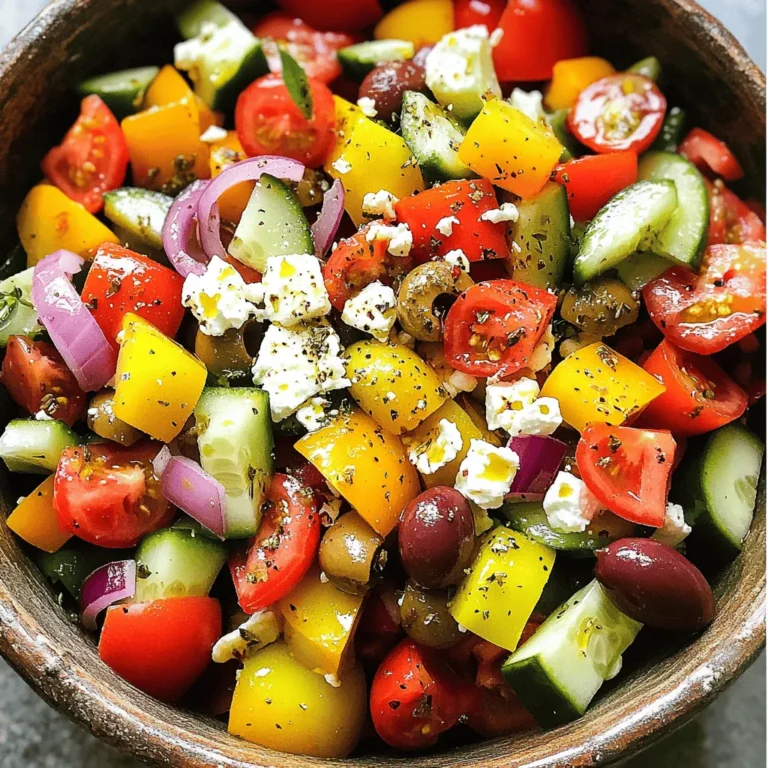Are you ready to dive into a bowl of freshness? Classic Greek Salad is more than just a side dish—it’s a burst of flavor and nutrition. This salad brings together ripe tomatoes, crisp cucumbers, and tangy feta cheese for a delightful experience. Join me as we explore the simple ingredients and easy steps to prepare this classic dish. Let’s bring vibrant Mediterranean flavors right to your table!
Ingredients
Fresh Vegetables
A Classic Greek Salad shines with fresh, bright veggies. Here’s what you need:
– 4 ripe tomatoes
– 1 cucumber
– 1 red onion
– 1 bell pepper
These vegetables add crunch and flavor. Choose ripe tomatoes for the best taste. A crisp cucumber gives a refreshing bite. A red onion brings a slight sweetness, while a bell pepper adds color.
Cheese and Olives
Next, we have cheese and olives, which are key to this salad:
– 200g feta cheese
– 100g Kalamata olives
Feta cheese provides a creamy texture and tangy flavor. Kalamata olives offer a rich and briny taste. Together, they make the salad truly special.
Dressing Components
Lastly, let’s mix up a simple dressing:
– 3 tablespoons extra-virgin olive oil
– 2 tablespoons red wine vinegar
– 1 teaspoon dried oregano
– Salt and pepper to taste
This dressing is easy to make. The olive oil adds richness. Red wine vinegar gives a nice tang. Dried oregano brings an earthy note, while salt and pepper enhance all the flavors.Enjoy these fresh ingredients in your next meal!
Step-by-Step Instructions
Prepare the Vegetables
– Chop tomatoes and cucumber. Use ripe tomatoes for the best taste. Dice the cucumber into small pieces, too.
– Slice red onion and bell pepper. Keep the onion slices thin. For the bell pepper, chop it into bite-sized pieces.
Combine Salad Ingredients
– Mix fresh vegetables in a salad bowl. Place all the chopped vegetables in a large bowl. Make sure they are evenly mixed.
– Gently fold in feta cheese and olives. Add crumbled feta cheese and Kalamata olives. Be careful not to break the feta too much.
Make the Dressing
– Whisk together dressing ingredients. In a small bowl, combine olive oil, vinegar or lemon juice, oregano, salt, and pepper.
– Drizzle over salad and toss gently. Pour the dressing on the salad. Toss everything carefully to coat without smashing the feta.
This process takes just about 15 minutes. You will enjoy a fresh and tasty Classic Greek Salad!
Tips & Tricks
Perfecting the Salad
To make your Greek salad shine, always use fresh, in-season vegetables. They taste better and add vibrant color. This gives your salad that crisp bite. When it comes to seasoning, balance is key. A sprinkle of salt brings out the flavors, while the olive oil adds richness. Try to find the right mix that suits your taste.
Presentation Ideas
Serving your salad in a chilled bowl makes it look even more inviting. A cold bowl keeps the salad crisp. For a touch of flair, garnish with extra herbs or whole olives. This adds a pop of color and makes your dish look gourmet.
Common Mistakes to Avoid
One common mistake is overdressing the salad. Too much dressing can drown the fresh flavors. Always start with a little and add more if needed. Another mistake is breaking the feta too much while mixing. Gently fold it in to keep those lovely chunks intact. This way, you enjoy the creamy texture in every bite.

Variations
Traditional Modifications
You can make simple changes to the Classic Greek Salad. One tasty option is to add capers. They give a salty, briny flavor that pairs well with the fresh veggies. Another great idea is to swap the red wine vinegar for lemon juice. This adds a bright, zesty note that enhances the salad’s freshness.
Regional Variants
Different regions in Greece have their own twists on this salad. For example, you can add arugula or spinach. These greens add a peppery taste that blends nicely with the other ingredients. You can also switch up the cheese. Goat cheese can be a creamy and tangy alternative to feta. This variation brings a new texture and flavor to the dish.
Vegan Adaptations
If you’re following a vegan diet, you can easily adapt this salad. Simply skip the cheese or use a plant-based alternative. This keeps the salad light but still tasty. To add crunch and protein, consider adding nuts like almonds or walnuts. They give a satisfying bite and enrich the salad’s flavor profile.
Storage Info
Refrigeration Tips
To keep your Greek salad fresh, store leftovers in an airtight container. This keeps air out and helps keep the veggies crisp. It is best consumed within 1-2 days. The longer it sits, the soggier it gets.
Avoiding Sogginess
To avoid sogginess, keep the dressing separate until you serve the salad. This helps the vegetables stay crunchy. Also, store the vegetables away from the dressing. That way, they won’t soak up too much liquid.
Freezing Considerations
Freezing Greek salad is not recommended. The vegetables lose their texture when frozen. If you have extras, try to eat them fresh. If you must freeze, only freeze the feta and olives. Use them later in cooking or other recipes.
FAQs
What is the origin of Classic Greek Salad?
Classic Greek salad, known as Horiatiki, comes from Greece. This salad reflects the simple way of life in rural Greece. People used fresh, seasonal ingredients from their gardens. The dish symbolizes the Mediterranean diet, rich in veggies, healthy fats, and flavors. It has roots in ancient times, emphasizing local produce and traditional tastes.
Can Classic Greek Salad be made in advance?
Yes, you can make Classic Greek salad ahead of time. To prep, chop the veggies and store them in the fridge. Keep the dressing separate to prevent sogginess. Mix everything just before serving. This way, the salad stays crisp and fresh. If you want a quick meal, this method works great.
What can I substitute for feta cheese in this recipe?
If you cannot eat feta cheese, try these options:
– Tofu: Crumbled tofu gives a similar texture and can soak up flavors.
– Nutritional yeast: This gives a cheesy flavor and is dairy-free.
– Vegan feta: Made from nuts or soy, it mimics the taste well.
– Cottage cheese: A softer alternative, but it changes the flavor a bit.
These substitutes allow you to enjoy the salad without dairy.
How many servings does the Classic Greek Salad yield?
The Classic Greek salad recipe serves four people. Each serving is a generous portion, perfect for a side dish or a light meal. You can easily double or triple the recipe for larger gatherings. Just adjust the ingredient amounts based on your needs.Combine chopped tomatoes, diced cucumber, sliced red onion, and chopped bell pepper in a bowl.
2. Gently fold in crumbled feta cheese and Kalamata olives.
3. Whisk together olive oil, red wine vinegar (or lemon juice), oregano, salt, and pepper.
4. Drizzle the dressing over the salad and toss gently.
5. Taste and adjust seasoning as needed.
This quick recipe brings fresh flavors to your table.
This blog gave a clear guide to making a Classic Greek Salad. We covered key ingredients, step-by-step instructions, and helpful tips. You learned how to prepare fresh vegetables, combine them with cheese and olives, and make a simple dressing. Remember to balance flavors and avoid overdressing. Feel free to experiment with variations or store leftovers correctly. A fresh Greek salad can brighten any meal and is easy to make. Enjoy creating your salad and sharing it with others!


